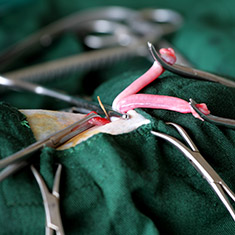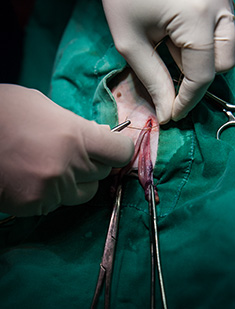Don’t Litter! Spay or Neuter Your Puppy
In case you haven’t heard, pet overpopulation is a huge problem, and as the economy continues to stagnate, the problem is getting worse. People are often forced to leave their pets behind when they lose their housing after losing a job, or they may surrender the dog to a shelter because they can no longer afford to care for him or her.

The problem is that shelters are already filled past capacity, and they are being forced to euthanize dogs because they are out of space. How can you help stop this alarming trend? Aside from adopting shelter dogs, the best way to ease overcrowding at shelters is to keep your dog from contributing to the overpopulation problem. Spay or neuter your dog as soon as your vet says he or she is old enough.
How bad is the problem?
According to the Humane Society as many as 6 – 8 million homeless animals are housed in shelters each year. Only half of these animals are adopted. The others are euthanized. That’s about one every eight seconds.
Whose fault is it? Many people want to blame the shelters or the Humane Society, but let me ask you this. If you were forced to take other people’s pets into your home every day and care for them, how many animals would you be able to take, assuming your financial situation didn’t change? Very few of us would be able to properly care for the number of dogs that would turn up without some sort of increase in our income.
Shelters are in the exact same situation. Every day, new pets are dropped off because someone in the family is allergic or because they can’t afford to feed the animal, or because the dog bit Aunt Margaret, or because they didn’t realize how much work it would be, or because they didn’t know how big the dog would get, or because they didn’t know that puppies chew up shoes.

The list of reasons for surrender is endless. Add to that the fact that many dogs wander away from home and are never claimed by their families. Then add in the number of puppies that are the result of unwanted, unplanned pregnancies.
When irresponsible pet owners allow their dogs to get pregnant, it compounds the already bad problem. It’s not the shelter’s fault they are out of room. It’s a problem caused by dog owners who don’t spay or neuter their pets. And it’s a problem to which all of us contribute when we don’t adopt shelter pets, when we don’t donate money to shelters to allow for additional cage space, and when we don’t volunteer our time in support of shelters.
The National Council on Pet Population Study and Policy is currently gathering and analyzing data in order to come up with recommendations on programs that will help reduce the number of homeless pets in the United States.
What if I want to breed or show my dog?
First, a word of caution: very, very few people make any real money by breeding, unless they are in the business professionally. By the time you take into account the vet bills and other expenses associated with puppies, plus the fact that you may not be able to sell all of the puppies, the profit margin just isn’t that big. And caring for puppies, particularly if they become sick, or if the mother rejects one or more of the litter, is time-consuming, sleep-depriving, and hard!
Same thing goes for showing. If you are showing dogs just for fun, have at it. But if you are hitting the show ring with the expectation that you will make money, approach it the same way you would tell your kids to approach a rock star career – don’t quit your day job!
That said, if you are going to show or breed your dog, obviously you won’t be spaying or neutering. Therefore, you must be responsible. Like so many things in life, most of the responsibility falls on the female. The rule of thumb is that if your dog is in heat, she doesn’t leave the house. Most dog sports will not allow dogs in heat to compete, and unless you have a fenced-in yard, you shouldn’t leave your dog outside without total supervision when she is in heat.
Isn’t it better for a female dog to have one litter before spaying?
This is a huge myth that has circulated for years. The fact of the matter is that a dog who is not spayed before her first heat cycle has seven times more risk of developing breast cancer. The sex hormones produced by unspayed dogs’ ovaries seem to sensitize or pre-dispose breast tissue to later develop cancer. To give you an idea of how important spaying is, dogs who are spayed prior to their first heat cycle have a risk of malignant mammary tumors of less than 1/10th of 1 percent. Dogs who are not spayed until after their second heat cycle have a risk of 26%.
What about male dogs?

Neutering does not show the strong link to cancer prevention that spaying does, but neutering has other benefits. Like men of any species, intact male dogs are desperate to find someone to mate with. They may become destructive as they try to tunnel out of your house or yard to find their true love. Once out, they are susceptible to diseases, fights, injuries, traffic, and cruelty.
Some surveys suggest that as many as 85% of dogs hit by cars are unaltered males. And, if your dog is not properly tagged or micro-chipped when he gets out, he may very well end up in a shelter, unable to get home.
Neutering has also been shown to make male dogs less aggressive, and it eliminates the risk of testicular tumors.
What if I want my children to experience the miracle of birth?
Puh-lease! Buy a video or go online, and your kids can see all you want them to see, without creating puppies that will be hard to get rid of and may end up in shelters. Plus, for every puppy you do give away or sell, that is one less puppy that will be adopted from a shelter.
What about cost?
This is one of those situations where you can pay now or you can pay later. The cost of taking care of a litter of puppies is much more than the cost of the spay/neuter surgery. And when an unaltered dog has puppies, or when unwanted dogs roam the streets, your tax dollars have to pay for their care. The American Veterinary Medical Association estimates that the capture, impoundment, and eventual destruction of unwanted animals costs taxpayers and private humanitarian agencies over a billion dollars each year.
If you can’t afford to take your dog to a regular veterinarian for spaying/neutering, check with your local shelter for low cost or free clinics. Most communities, vets, advocacy organizations, shelters, and rescue organizations regularly host these clinics as a proactive measure for dealing with pet overpopulation.
If you’re really worried about cost, adopt your dog from a shelter that has a spay/neuter policy. Many shelters will not release an animal until he or she has been altered. The cost of the surgery is included in your adoption fee. Alternatively, some shelters offer a spay/neuter deposit. You give them a certain amount of money when you take the pet home, but then you bring back a certificate from your vet when you have the surgery done, and your money is refunded.
What does spaying involve?
Now that we’ve covered all of the reasons why you ought to spay or neuter your dog, let’s talk about the actual procedure. Spaying is very similar to what is called in humans a hysterectomy. Quite simply, the veterinarian anesthetizes your dog, then opens her abdomen and removes her uterus and ovaries. The opening is stitched closed, usually in three layers to hold everything together. The two inner layers of stitches will dissolve, and sometimes the skin layer will. If not, you will need to have the stitches removed in 10 – 14 days.
The vet may keep your dog overnight after the surgery to observe her for any complications, or she may be sent home as soon as she is up and walking.
After-effects of spaying
Your dog should not be fed the evening after surgery, as she may be a little nauseous from the anesthetic. Regular diet can be re-started the next day.
Your dog may have a slight cough after surgery because of the breathing tube that was down her throat during surgery. The cough should go away in a few days.
If your dog will not leave her stitches alone, you may need to borrow an Elizabethan collar from your vet to prevent her from removing her stitches. It looks funny, and it’s not very comfortable, but it does work.
Try to keep your dog quiet for about a week after the surgery. No long runs in the park, no wrestling matches with the kids. If the dog is overly active, she may develop a fluid accumulation under her incision. Sometimes this goes away on its own, but it should be vet-checked, particularly if it is draining.
As with any surgery, there is a slight chance of infection. Monitor your dog’s incision for drainage, swelling, redness, and excessive warmth following surgery. If your dog develops a fever, call the vet immediately.
Marvista Vet has an excellent overview of the spaying process on their website.
What is involved in neutering a dog?
The neutering procedure is much simpler than spaying. A small incision is made in the scrotal sac and the testicles are removed through the incision. Usually, there are no stitches required. Afterward, the scrotal sacs simply shrivel up without the testicles inside to fill them out. If desired, prosthetic testicles can be inserted to preserve the dog’s appearance.
What to expect after neutering
Your dog will be able to return to his normal activities within a day or two. He may have a little swelling or bruising, but that should go away in a few days. As with spaying, keep an eye out for infection until the dog is fully healed. Here is the Marvista Vet page on neutering.
For more information on spaying and neutering please see our article on Doggies.com.
Doggies Den: Latest Articles
 Homemade Thanksgiving Treats for Your Dog
Homemade Thanksgiving Treats for Your Dog
NUTRITION We all want to include our dogs in our holiday celebrations, but hopefully, you're aware that sharing table scraps with your dog isn't always the best idea.
 Keeping Your Dog Safe during the Summer Months
Keeping Your Dog Safe during the Summer Months
HEALTH Summer is coming on fast, so it’s time to plan how you will keep your dog safe and healthy through the lazy, carefree, warm days.
 Vaccination Time Again-Keeping Your Puppy Healthy
Vaccination Time Again-Keeping Your Puppy Healthy
DOG HEALTH So you have your new puppy picked out. There are quite a few shots, treatments and examinations that will keep the newest member of your family healthy.
 Canine Thanksgiving Feast
Canine Thanksgiving Feast
NUTRITION With the wide variety of food at Thanksgiving dinner, chances are you'll want to give your dog something special, too. If you're contemplating what to feed your dog for the holiday, here is a guide to a great Canine Thanksgiving Feast.
 Dog Walking Tips Every Owner Should Know
Dog Walking Tips Every Owner Should Know
DOG FUN Walking your dog is not only crucial to keeping him healthy and happy, it strengthens the bond between your canine friend and his caregiver. There are a lot of obstacles out there. Don’t forget these simple tips to keep your walk fun and safe in the outside world.
 The Benefits of Physiotherapy for your Dog
The Benefits of Physiotherapy for your Dog
HEALTH The same techniques that physiotherapists use to treat a variety of injuries and conditions in humans have been adapted to suit animals with great success. Family pets, show dogs, and working dogs can all benefit greatly from physiotherapy. Dogs whose activities involve a lot of agility are especially susceptible to the types of problems that physiotherapy can address.
 The Decision- Adding a Dog to Your Family
The Decision- Adding a Dog to Your Family
FIRST TIME OWNERSBringing a dog into your family is a decision where many people don’t realize it’s magnitude until after they have the dog. There are a number of things that you need to research before you decide to purchase a dog, and it starts right in your own home.
 Bringing Your Dog Into Your New Baby's Life
Bringing Your Dog Into Your New Baby's Life
HEALTH Many believe that a dog and a new baby cannot happily coexist, so therefore the dog has to go. This is not necessarily the case.  A new baby does not mean you have to abandon your dog.

Doggies Den:
Most Popular Articles

Dog Pregnancy Symptoms
HEALTHIf you suspect your dog might be pregnant, check out part one in this series on pregnant dogs, where we cover pregnant dog symptoms.

Dog Birth
HEALTHIn the third article of our dog pregnancy series, we look at the wonderful, but messy, process of bringing newborn puppies into the world.

Indoor Dog Potties
DOG PRODUCTSIt's been a long day at work. You were so busy, you didn't even take time to eat a sandwich, let alone run home to let your dog out. You're on your way home, knowing the poor dog is crossing his or her legs by now, when your car breaks down, delaying you even further. Can't somebody make this easier?

Your Dog’s Digestive System
PHYSIOLOGYEver wonder why your dog eats so fast? Or why he eats gross things? Or why he gets sick to his stomach? Or why his waste stinks so bad? Some of these things are normal, some are not.

Canine Respiratory System
BREATHINGThe basic function of your dog's respiratory system is to bring oxygen in to and remove carbon dioxide from the body. Knowing the symptoms of respiratory diseases can help you help your stay healthy.

Shelter Dog Adoption Tips for Success
ADOPTION Are you intimidated by the prospect of "rescuing" a dog from a shelter? One reason that you may be wary of adopting a dog from a shelter is not knowing how to choose. Adopting a dog from a shelter can be a rewarding process, if you're prepared to do a reasonable amount of research.

Canine Urinary Tract Infections
SYMPTOMS AND TREATMENTDoes your dog seem to be having trouble relieving his or her bladder? Learn how to recognize the signs of urinary tract infections and how to treat them before they spread.

What to do for Dog Diarrhea
SYMPTOMS AND REMEDIESIf you have dogs in your house for any length of time, you have likely experienced at least one bout of dog diarrhea. Beyond the pain in the tuckus involved in cleaning up the mess, you should know what causes diarrhea, and when it's important to see the vet.

What to do for a Dog Bite
DOG BEHAVIOR Getting bitten by a dog can be scary, and you may be tempted to run around in circles for a while, trying to figure out what to do. Here's our guide to help you manage the situation.

Top Ten Tips for Living with a Senior Dog
DOG HEALTH Bringing home a new puppy is so exciting, but it doesn’t take all that long for your exuberant puppy to grow into a senior dog who may have special needs. Here are the doggies.com top ten tips for taking care of your companion who has been with you through so much.
